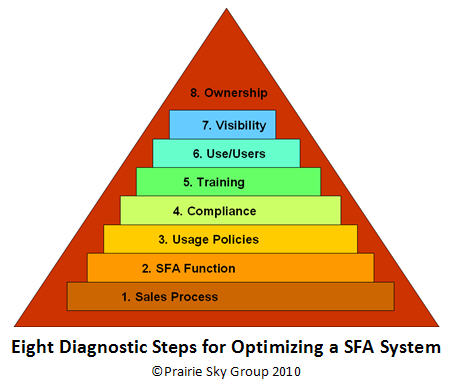Who owns the system? Oversight, Ownership, Administration and Change Management
This could easily be the first question. It’s essential to know the differences between the above. If different players don’t know their roles or responsibilities, then nothing gets accomplished. In many organizations, failure becomes a matter of not clearly assigning roles.
As senior management, your job is oversight. You are the customer for the system. Management should get paid to think of the consequences of problems, decide priorities and then get others to solve those problems. It is not your job to solve the problem itself.
In many organizations, ownership for the SFA system is often vague or shared. It can be owned by IT, (which is the wrong place for it), or by sales (sales has other battles to fight), or by operations, most often sales operations reporting up to sales. When ownership is unclear, nothing gets done. But we need to know:
a. Who owns what?
b. Do they know it?
c. Have they accepted it?
d. Do they have the skills?
e. Can they do it?
Ownership means that person is responsible for the success of the system. Success is defined by the metrics you put in place. It doesn’t mean this person does all the dirty work, but rather they lead a team, assign tasks, measure results and report progress and needs to management.
Administration is the technical support trained in the SFA and having database expertise. Training and support of this person is essential.
Lastly, having reached a point where your SFA is running and you’ve reached your primary goals, it’s essential to put in place a Change Management System for continued improvements (See Diagnostic Question #6).
When you take a systemic approach to diagnosing and improving your SFA or CRM system, you will find the improvements have a multiplying effect on each other. Following this diagnostic process will allow you to focus on the business and not the system.
Good luck and thanks to all those who have helped me through this process. If you’ve stuck with me through this series, here is a quick chart to help guide you.

